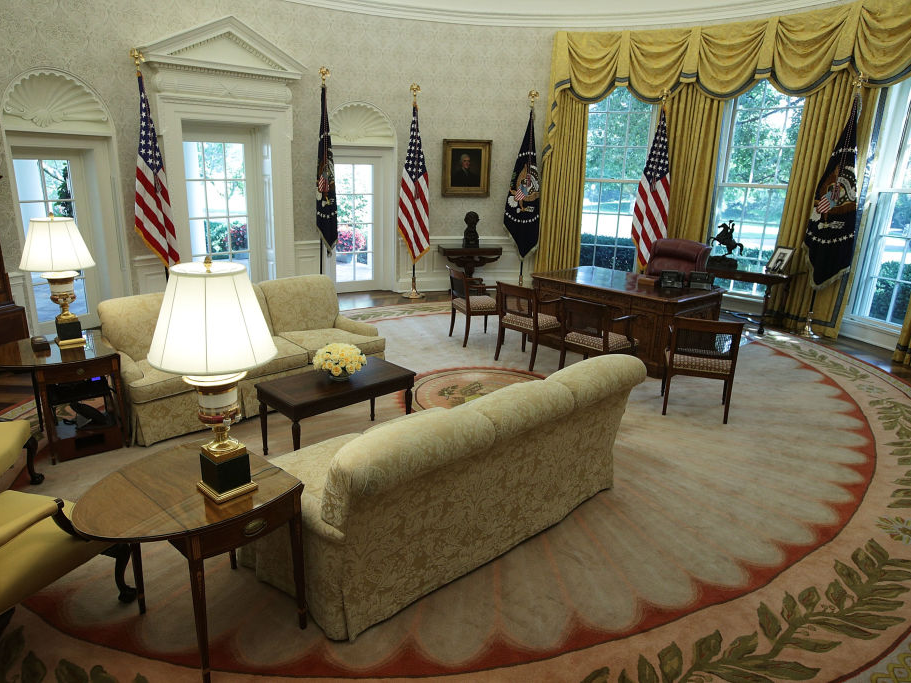• The Oval Office is the official office of the president of the United States.
• In modern times, many new presidents have redesigned the room.
• These refurbishments typically reflect their personal tastes, signal their political leanings, and commemorate the figures who they admire.
The Oval Office is more than just an office.
It’s a symbol of the authority and power of the US presidency – and a great spot for photo ops.
But, while all presidents from John Adams onward have lived in the White House, the Oval Office is a somewhat more modern convention.
The first Oval Office was the brainchild of President William Taft, who added the room when he expanded the West Wing. According to the White House Museum, the room had a green scheme, with olive walls, forest drapes with eagle valances, and a softer green rug. Presidents Woodrow Wilson, Warren G. Harding, Calvin Coolidge, and Herbert Hoover all used this original Oval Office, which was gutted in a 1929 fire.
The modern Oval Office was born during the tenure of Franklin D. Roosevelt. Since then, new presidents have typically redesigned the space, swapping out the drapes, rug, chairs, and desk, switching up the artwork, and adopting new color schemes.
The changes to the Oval Office aren't always simple matter of personal taste. The redesign often allows the president to subtly signal certain political leanings and commemorate the historical figures who they admire.
Oval Office decorations can also be a source of political sniping. Under President Donald Trump's administration, White House officials chose to anonymously bash Barack Obama by alleging that he'd left the room's wallpaper stained and damaged. They said they were engaging in a $3.4 million redesign in order to restore the room's "luster" and "glory," The Guardian reported.
And sometimes, certain decorating choices can even result in a public backlash - like Trump's choice to display a portrait of Andrew Jackson, or Obama's decision to move a bust of Winston Churchill from the Oval Office to the Treaty Room.
With that in mind, here's a look back in time at the Oval Office over the years, from FDR to Trump:
Roosevelt is the father of the modern Oval Office. According to the blog Our White House, he hated the old room because it "lacked windows and privacy." The new space was sunnier and located closer to his staff. However, during WWII, the president may have been required to move his desk away from the window, for security reasons.

Source: Our White House, White House History, White House Museum
FDR kept the old office's green theme alive, selecting green drapes and a blue green rug. He also kept a marble mantel and two sconces, from the old room. The room also featured many armchairs and arched-back chairs, ship models, Herbert Hoover's old desk, prints of the Hudson Valley, a painting of George Washington, and an animal skin rug.

Source: Our White House, White House History, White House Museum
Harry Truman commemorated Roosevelt, who died in office, by featuring a large photograph of him in the Oval Office. The art he displayed was eclectic, and included a portrait of Washington, depictions of Simon Bolivar and Jose de San Martin that were gifts from Venezuela and Argentina, a plaque of the Missouri State Seal, and plane models.

Source: White House Museum, The Truman Library
He used Theodore Roosevelt's old desk, and kept to a color scheme of blues, greens, and grays. He also famously kept a sign on his desk that read, "The buck stops here, I'm from Missouri."

Source: White House Museum, The Truman Library
Dwight Eisenhower seemingly wasn't too picky about his office decor. He didn't change the design, keeping Teddy Roosevelt's desk, and Truman's curtains and rug. He did add a painting of Confederate general Robert E. Lee, some landscape paintings, and a statue of Abraham Lincoln.

Source: White House Museum
John F. Kennedy was in the process of redesigning the Oval Office when he was assassinated. The idea was to install a new red rug and pale curtains. In terms of furniture, Kennedy added a rocking chair, white sofas, and replaced the sconces with brass lantern. The sailing enthusiast also displayed paintings of naval battles, photos of sailboats, and ship models.

Source: White House Museum
First Lady Jacqueline Kennedy was responsible for introducing the famed Resolute desk to the Oval Office. The piece had been carved from timbers of the British ship H.M.S. Resolute. Queen Victoria had given it to Rutherford B. Hayes as a present.

Source: White House Museum, White House History
Lyndon B. Johnson initially retained JFK's red rug and pale curtains, but ultimately swapped the former out for FDR's bluish green rug. He added the sconces back to the mantel, and brought in the desk he'd used since his time in the Senate. He also featured the Bronco Buster — a sculpture of a cowboy riding a bucking Bronco.

Source: White House Museum
Johnson added three televisions to the room, covered the floor with a linoleum surface, and displayed paintings of Washington, Jackson, and Jefferson, and even a bust of himself. He also once gave a bust of himself to Pope Paul VI as a gift.

Source: White House Museum, US Senate, "Air Force One: The Aircraft That Shaped the Modern Presidency"
Richard Nixon favored yellow drapes, a royal blue rug designed by First Lady Pat Nixon, and a desk he believed had been used by Woodrow Wilson. The desk, in fact, had belonged to Ulysses S. Grant's vice president Henry Wilson.

Source: White House Museum, "Before the Fall: An Inside View of the Pre-Watergate White House"
Nixon swapped out a number of portraits of Washington before deciding on one, and displayed bird figurines, as well as the photo "Earthrise." The image of planet earth had been taken during the 1968 Apollo 8 mission.

Source: White House Museum, "Before the Fall: An Inside View of the Pre-Watergate White House"
For Gerald Ford, a gold and blue floral rug and pumpkin-colored drapes were the order of the day. Ford also introduced Queen Anne armchairs and striped sofas to the Oval Office, kept the Wilson desk, and banished the sconces.

Source: White House Museum
Ford also took on paintings and sculptures of Washington, Passamquoddy Bay in Maine, Washington D.C., Benjamin Franklin, and Lincoln. He also brought back the Bronco Buster.

Source: White House Museum
Jimmy Carter opted against extensive redecorating, just like Ike before him. He did bring back the Resolute desk, and moved some sofas around.

Source: White House Museum
In terms of new artwork, Carter featured busts of Truman, Jefferson, and Washington, along with some ship models.

Source: White House Museum
Reagan also mostly left the Oval Office alone during his first term. After his reelection, he adopted a pale gold rug with a sunbeam design, that had been designed by First Lady Nancy Reagan.

Source: White House Museum
Reagan replaced the room's floor, added a portrait of Jackson, and featured family photos. Like Carter, he kept The Bronco Buster and the Resolute desk; he also added another similar Frederic Remington sculpture called Rattlesnake.

Source: White House Museum
George H.W. Bush went for a pale blue color scheme, in terms of the rug and the drapes. Decorations included paintings of Washington, Rutland Falls, Vermont, the Teton range, and Jackson, ship models, and family photos. He also had a penchant for luminist landscape paintings.

Source: White House Museum
Bush brought in a brand new desk — the C&O desk, which was originally carved for the Chesapeake & Ohio Railway offices and subsequently donated to the White House. He'd used it as vice president, too.

Source: White House Museum
After taking the helm at the White House, Bill Clinton went for gold drapes and a navy blue rug. He featured paintings by Childe Hassam and Norman Rockwell, as well as a historical painting of African Americans waiting for the Emancipation Proclamation to be declared.

Source: White House Museum
He brought back the Resolute desk and the Bronco Buster, and added "The Thinker" by Auguste Rodin, busts of FDR and Lincoln, and family pictures.

Source: White House Museum
For George W. Bush's White House, First Lady Laura Bush designed a new pale gold rug with a sunbeam design. The Oval Office also took on antique gold drapes, and kept the Resolute desk.

Source: White House Museum
The president hung up a number of paintings by Texan artists. Bush's range of busts included Eisenhower, Lincoln, and one of Winston Churchill that UK Prime Minister had lent to him after 9/11. The Bronco Buster and Rattlesnake also continued their White House tenures.

Source: White House Museum, Architectural Digest
Barack Obama's beige Oval Office rug was encircled with quotes from Lincoln, Teddy Roosevelt, FDR, Kennedy, and Martin Luther King Jr. He also took on reddish drapes and striped walls, retained the Resolute desk, and featured a copy of the Emancipation Proclamation and a program from King's "I Have a Dream" speech.

Source: White House Museum
Like Clinton, Obama displayed a Hassam painting, along with other pieces of art depicting the Teton range, Washington, Lincoln, and the Statue of Liberty. He also set out family pictures and kept The Bronco Buster. In terms of busts, he featured ones of King and Lincoln.

Source: White House Museum, The New York Times
Trump's Oval Office is a blend of elements from a number of former presidents. He's adopted the Resolute desk, the younger Bush's couches, Reagan's rug, Clinton's golden drapes, and, of course, The Bronco Buster.

Source: White House Museum, The Atlantic
In terms of artwork, Donald Trump has opted to go with portraits of Washington, Lincoln, Jefferson, and Jackson, along with an equestrian statue of the former. The room also features busts of Churchill, King, and Lincoln, photos of his parents, a collection of law enforcement badges, and a letter Nixon wrote Trump in 1987.

Source: White House Museum, The Atlantic, The Washington Examiner

